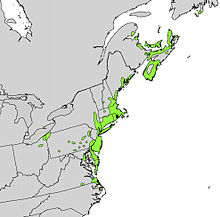Myrica pensylvanica
| Myrica pensylvanica | ||||||||||||
|---|---|---|---|---|---|---|---|---|---|---|---|---|

Myrica pensylvanica |
||||||||||||
| Systematics | ||||||||||||
|
||||||||||||
| Scientific name | ||||||||||||
| Myrica pensylvanica | ||||||||||||
| Mirbel |
Myrica pensylvanica is a species of the genus Myrica within the family of myricaceae (Myricaceae). It is common in eastern North America .
description
Vegetative characteristics

Myrica pensylvanica grows as a deciduous shrub or rarely as a small tree and reaches heights of up to 2, rarely up to 4.5 meters. Colonies ( clones ) are formed by rhizomes . The bark of the twigs is initially reddish-brown and dotted with yellow glands and later becomes whitish-gray; it is densely hairy.
The alternate leaves arranged on the branches are divided into a petiole and a leaf blade. The mostly parchment-like, less often leathery, simple leaf blade is lanceolate to elliptical or sometimes wrong with a length of 2.5 to 6.5, rarely up to 7.8 centimeters and a width of 1.5 to 2.7 centimeters - Egg-shaped with a wedge-shaped to narrowing base and blunt to rounded, sometimes pointed or short-pointed upper end. The leaf margin is sometimes smooth, usually serrated from top to middle. The underside of the leaf is light green, finely hairy on the leaf veins and overall somewhat to densely glandular. The upper side of the leaf is dark green, finely hairy, especially along the midrib, and has no or sparse yellowish-brown glands. When the leaves are crushed they are sticky and give off an aromatic odor.
Generative characteristics
The flowers are in catkins and are 3 to 18 millimeters long; their color ranges from green to red. The wrinkled stone fruit has a diameter of 3 to 5.5 millimeters with a pale purple wax layer.
ecology
Myrica pensylvanica has root nodules that contain nitrogen-fixing microorganisms and thus allow it to grow in relatively nutrient-poor soils .
It is an important source of food for the Great Warbler .
distribution
Myrica pensylvanica occurs in eastern North America from Newfoundland west to Ontario and Ohio and south to North Carolina .
Systematics
The first description of Myrica pensylvanica was in 1804 by Charles François Brisseau de Mirbel .
Myrica pensylvanica is one of the Myrica species that z. B. from the Integrated Taxonomic Information System in the genus Morella (Syn .: Morella pensylvanica ).
Similar species
Myrica pensylvanica is very similar to Myrica caroliniensis ; these two species are occasionally brought together, notwithstanding the fact that Myrica caroliniensis is evergreen or very late deciduous. Myrica pensylvanica is also similar to Myrica cerifera , but only has scent glands on the underside of the leaves and is not particularly aromatic, whereas Myrica cerifera has glands on the top and bottom of the leaves and smells aromatic when the leaves are crushed. Myrica pensylvanica forms hybrids with both species .
use
The fruits can be used to make a wax for candle production. The early American colonists cooked them to extract the sweet-smelling wax. The candles made from it burn cleanly.
Common names
English-language common names are Northern bayberry, waxberry, tallow bayberry, small waxberry, tallowshrub, swamp candleberry, candlewood, candletree, tallowtree, and a French-speaking one is myrique de Pennsylvanie.
swell
literature
- Allan J. Bornstein: Myricaceae. In: Flora of North America Editorial Committee (Ed.): Flora of North America North of Mexico , Volume 3 - Magnoliidae and Hamamelidae , Oxford University Press, New York and Oxford, 1997, ISBN 0-19-511246-6 . Myrica pensylvanica Mirbel in H. Duhamel du Monceau et al. - same text online as the printed work.
Individual evidence
- ↑ a b c d e f g h Allan J. Bornstein: Myricaceae. In: Flora of North America Editorial Committee (Ed.): Flora of North America North of Mexico , Volume 3 - Magnoliidae and Hamamelidae , Oxford University Press, New York and Oxford, 1997, ISBN 0-19-511246-6 . Myrica pensylvanica Mirbel in H. Duhamel du Monceau et al. - same text online as the printed work.
- ^ ITIS Standard Report Page: Morella pensylvanica . Integrated Taxonomic Information System . Retrieved June 6, 2014.
- ^ Mark H. Brand: Myrica pensylvanica: Northern Bayberry . In: Plant UConn Database of trees, shrubs and vines . Archived from the original on August 1, 2010. Retrieved October 29, 2010.
- ^ History of Candles . National Candle Association. 2010. Archived from the original on May 17, 2012. Retrieved October 29, 2010.





